Related Research Articles
A mandolin is a stringed musical instrument in the lute family and is generally plucked with a pick. It most commonly has four courses of doubled strings tuned in unison, thus giving a total of eight strings. A variety of string types are used, with steel strings being the most common and usually the least expensive. The courses are typically tuned in an interval of perfect fifths, with the same tuning as a violin. Also, like the violin, it is the soprano member of a family that includes the mandola, octave mandolin, mandocello and mandobass.

The mandocello is a plucked string instrument of the mandolin family. It is larger than the mandolin, and is the baritone instrument of the mandolin family. Its eight strings are in four paired courses, with the strings in each course tuned in unison. Overall tuning of the courses is in fifths like a mandolin, but beginning on bass C (C2). It can be described as being to the mandolin what the cello is to the violin.
Carlo Cecere was an Italian composer of operas, concertos and instrumental duets including, for example, some mandolin duets and a concerto for mandolin. Cecere worked in the transitional period between the Baroque and Classical eras.
In music, a method is a kind of textbook for a specified musical instrument or a selected problem of playing a certain instrument.

The mandore is a musical instrument, a small member of the lute family, teardrop shaped, with four to six courses of gut strings and pitched in the treble range. Considered a French instrument, with much of the surviving music coming from France, it was used across "Northern Europe" including Germany and Scotland. Although it went out of style, the French instrument has been revived for use in classical music. The instrument's most commonly played relatives today are members of the mandolin family and the bandurria.

Raffaele Calace was an Italian mandolin player, composer, and luthier.
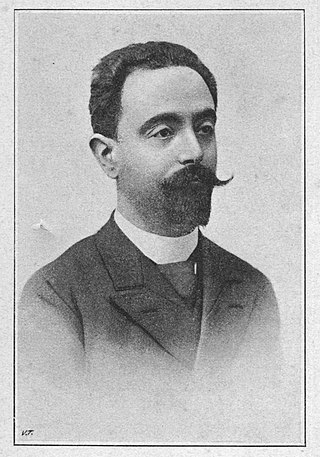
Carlo Munier (1858–1911) was an Italian musician who advocated for the mandolin's acknowledgement among as an instrument of classical music and focused on "raising and ennobling the mandolin and plectrum instruments". He wanted "great masters" to consider the instrument and raise it above the level of "dilettantes and street players" where it had been stuck for centuries. He expected that the mandolin and guitar would be taught in serious orchestral music schools and incorporated into the orchestra. A composer of more than 350 works for the mandolin, he led the mandolin orchestra Reale circolo mandolinisti Regina Margherita named for its patron Margherita of Savoy and gave the queen instruction on the mandolin. As a teacher, he wrote Scuola del mandolino: metodo completo per mandolino, published in 1895.

The liuto cantabile, also termed a liuto moderno, is an uncommon ten-stringed mandocello. This bass variant of the mandolin family was developed by the Neapolitan luthiers of the Vinaccia family in the late 19th century and perfected by Raffaele Calace. The scale of a modern Calace-manufactured liuto cantabile is 61 cm (24"). The instrument overlaps or is equivalent to the mandolone and mandocello.
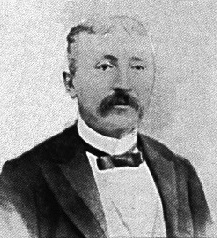
Giuseppe Bellenghi was a virtuoso violoncellist and mandolinist, and composer. He was remembered in 1914 as "a devoted champion of the mandolin."

A mandolone is a member of the mandolin family, created in the 18th century. It is a bass range version of the Neapolitan mandolin. Its range was not as good as the mandocello, which replaced it in mandolin orchestras, and had largely disappeared in the 19th century.

Ferdinando de Cristofaro was one of the most celebrated mandolin virtuosi of the late 19th Century. He was also a classical pianist, teacher, author and composer, who performed at the chief courts of Europe, and received the royal appointment of mandolinist to the King of Italy.
Belisario Mattera was an Italian musician and mandolin virtuoso who is recorded as the first mandolinist to give instruction on his instrument to the Princess Princess Margherita of Savoy, was the Queen consort of the Kingdom of Italy during the reign (1878–1900) of her husband, Umberto of the Royal family of Italy. For a period of from ten to fifteen years in the nineteenth century the nobility and aristocracy of the country followed the example of their Sovereign, and the mandolin enjoyed great favour amongst the wealthy classes.
Ugo Orlandi is a musicologist, a specialist in the history of music, a university professor and internationally renowned mandolinist virtuoso. Among worldwide musicians, professional classical musicians are a small group; among them is an even smaller group of classical mandolinists. Among members of this group, Ugo Orlandi is considered "distinguished." Music historian Paul Sparks called him "a leading figure in the rehabilitation of the eighteenth-century mandolin repertoire, having recorded many concertos from this period."

Pasquale Vinaccia was an Italian luthier, appointed instrument-maker for the Queen of Italy, and maternal grandfather to Carlo Munier. In 1835 he improved the mandolin, creating a version of the instrument that used steel wires for strings, known today as the "Neapolitan Mandolin." His use of steel strings has become the dominant way of stringing mandolins.

Mauro Squillante is a plucked-instruments researcher, a mandolinist and president of the Accademia Mandolinistica Napoletana in Naples, Italy, teaching classical-music mandolin. He also teaches at the Conservatory "Piccinni" of Bari and the "Martucci" of Salerno. He is important in the movement to revive the Neapolitan mandolin in its native city, where the instrument went out of style and its history became hard to access. His specialty is "ancient plucked string instruments" including the mandolin, mandola, mandolone, colascione and zither.
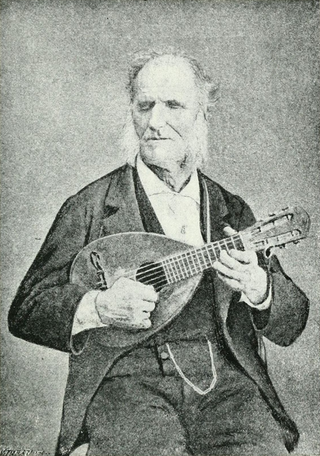
Giovanni Vailati was an Italian mandolinist who reached the virtuosic-level of playing ability and was able to travel and perform throughout Europe. Entirely self taught on his instrument, he was described by Philip J. Bone as a "natural genius on his instrument, who by his remarkable performances, became known throughout his native land as 'Vailati the blind, the Paganini of the mandolin.'" He is important as one of the first generations of quality performers to use mandolin. He was one of a small number of mandolinists of the 19th century to play the mandolin in the concert halls of Europe after the Napoleonic War, who played with excellence in spite of indifference and diffidence toward their chosen instrument. Pietro Vimercati was another, whose concerts predated Vailati's by about 30 years. Also performing in Europe in the years following 1815 was Luigi Castellacci.
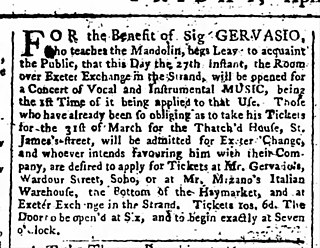
Giovanni Battista Gervasio was an Italian musician and composer. Born in Naples he was one of the first generation of virtuoso-mandolinists who left Italy and played the mandolin in Europe in the 18th century. He was a composer for the mandolin and his works can be found scattered in 18th century collections such as the Gimo music collection and the Bibliothèque Nationale de France. He also wrote a mandolin method Methode facile pour apprendre a quatre cordes, instrument pour les dames, published in Paris in 1767. He performed in London 1768 and in Frankfurt-on-the-Main on December 10, 1777, and the Concert Spirituel in Paris on December 24, 1784. He advertised in 1785 that he was master of singing and mandolin to Her Royal Highess, the Princess of Prussia. A work of music addressed to her exists today in the Bibliothèque Nationale de France.
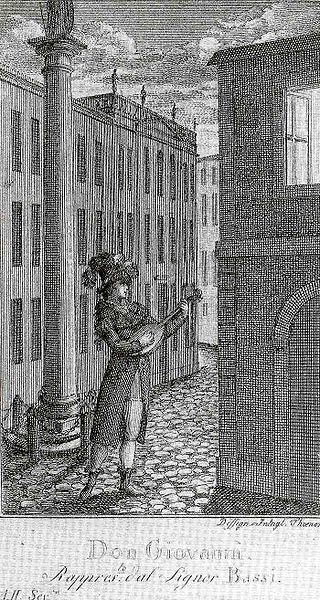
The mandolin is a modern member of the lute family, dating back to Italy in the 18th century. The instrument was played across Europe but then disappeared after the Napoleonic Wars. Credit for creating the modern bowlback version of the instrument goes to the Vinaccia family of Naples. The deep bowled mandolin, especially the Neapolitan form, became common in the 19th century, following the appearance of an international hit, the Spanish Students. They toured Europe and America, and their performances created a stir that helped the mandolin to become widely popular.

Following its invention and development in Italy the mandolin spread throughout the European continent. The instrument was primarily used in a classical tradition with mandolin orchestras, so called Estudiantinas or in Germany Zupforchestern, appearing in many cities. Following this continental popularity of the mandolin family, local traditions appeared outside Europe in the Americas and in Japan. Travelling mandolin virtuosi like Carlo Curti, Giuseppe Pettine, Raffaele Calace and Silvio Ranieri contributed to the mandolin becoming a "fad" instrument in the early 20th century. This "mandolin craze" was fading by the 1930s, but just as this practice was falling into disuse, the mandolin found a new niche in American country, old-time music, bluegrass and folk music. More recently, the Baroque and Classical mandolin repertory and styles have benefited from the raised awareness of and interest in Early music.
References
- 1 2 3 Bone, Philip J. (1914). The Guitar and Mandolin. Schott and Company. p. 175.
...an Italian mandolinist and guitarist of repute, who lived in Naples...the first teacher to give serious instruction on the mandolin to the virtuoso and composer Carlo Munier...produced one of the greatest exponents of the mandolin.
- 1 2 3 4 Biaggi, G. A. (March 20, 1875). "The Lute and the Mandolin, with some remarks on Sig. Giovanni Vailati in connection with them (reprint from La Gazetta Musicale in Milan)". The Musical World. Vol. 53, no. 12. London: William Duncan Davison. pp. 204–205. Retrieved September 20, 2015.
Though the instrument is entirely out of fashion, the house of Ricordi published last year [1874] at Milan A Metodo per Mandolino, a well planned work, well carried out, by Sic. Carmine De-Laurentiis.
- ↑ Sparks, Paul (1995). The Classical Mandolin. New York: Oxford University Press. p. 45. ISBN 978-0-19-517337-6.
Federico Sacchi... Later compiled an English edition of the tutor by Carmine de Laurentiis
- 1 2 3 Sparks, Paul (1995). The Classical Mandolin. New York: Oxford University Press. pp. 1–9. ISBN 978-0-19-517337-6.
- 1 2 Sparks, Paul (1995). The Classical Mandolin. New York: Oxford University Press. pp. 9–14. ISBN 978-0-19-517337-6.
Fede
- 1 2 Snaar, Gevoelige. "History of the Mandolin, The Neapolitan Mandolin" . Retrieved September 21, 2015.
In the 19th century the mandolin disappeared from music life as a result of the changed music style. The instrument lived on in the Italian folk music. The techniques of classical mandolin masters became forgotten. The tremolo became the main playing technique in which one tried to imitate the bowed tone of the violin.